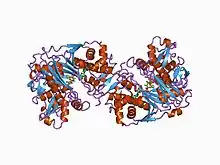| FGGY family of carbohydrate kinases, N-terminal domain | |||||||||
|---|---|---|---|---|---|---|---|---|---|
 enterococcus casseliflavus glycerol kinase complexed with glycerol | |||||||||
| Identifiers | |||||||||
| Symbol | FGGY_N | ||||||||
| Pfam | PF00370 | ||||||||
| Pfam clan | CL0108 | ||||||||
| InterPro | IPR018484 | ||||||||
| PROSITE | PDOC00408 | ||||||||
| SCOP2 | 1gla / SCOPe / SUPFAM | ||||||||
| CDD | cd00366 | ||||||||
| |||||||||
| FGGY family of carbohydrate kinases, C-terminal domain | |||||||||
|---|---|---|---|---|---|---|---|---|---|
 escherichia coli glycerol kinase mutant with bound atp analog showing substantial domain motion | |||||||||
| Identifiers | |||||||||
| Symbol | FGGY_C | ||||||||
| Pfam | PF02782 | ||||||||
| Pfam clan | CL0108 | ||||||||
| InterPro | IPR018485 | ||||||||
| PROSITE | PDOC00408 | ||||||||
| SCOP2 | 1gla / SCOPe / SUPFAM | ||||||||
| CDD | cd00366 | ||||||||
| |||||||||
In molecular biology the FGGY carbohydrate kinase family is a family of evolutionarily related carbohydrate kinase enzymes. These enzymes include L-fuculokinase EC 2.7.1.51 (gene fucK); gluconokinase EC 2.7.1.12 (gene gntK); glycerol kinase EC 2.7.1.30 (gene glpK); xylulokinase EC 2.7.1.17 (gene xylB); D-ribulose kinase EC 2.7.1.47 (gene FGGY/YDR109c);[1] and L-xylulose kinase EC 2.7.1.53 (gene lyxK). These enzymes are proteins of from 480 to 520 amino acid residues.
These enzymes consist of two domains. The N-terminal and C-terminal domains both adopt a ribonuclease H-like fold and are structurally related to each other.[1][2][3]
References
- 1 2 Singh C, Glaab E, Linster C (2016). "Molecular Identification of D-Ribulokinase in Budding Yeast and Mammals". J. Biol. Chem. 292 (3): 1005–1028. doi:10.1074/jbc.M116.760744. PMC 5247636. PMID 27909055.
- ↑ Hurley JH, Faber HR, Worthylake D, Meadow ND, Roseman S, Pettigrew DW, Remington SJ (January 1993). "Structure of the regulatory complex of Escherichia coli IIIGlc with glycerol kinase". Science. 259 (5095): 673–7. Bibcode:1993Sci...259..673H. doi:10.1126/science.8430315. PMID 8430315. S2CID 20908371.
- ↑ Ormo M, Bystrom CE, Remington SJ (November 1998). "Crystal structure of a complex of Escherichia coli glycerol kinase and an allosteric effector fructose 1,6-bisphosphate". Biochemistry. 37 (47): 16565–72. doi:10.1021/bi981616s. PMID 9843423.
This article is issued from Wikipedia. The text is licensed under Creative Commons - Attribution - Sharealike. Additional terms may apply for the media files.